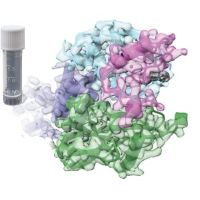Specification
| Description | Recombinant protein from the full-length sequence of Homo sapiens ribosomal protein S6 kinase A3 (RPS6KA3) (NM_004586). |
| Organism | Homo sapiens (Human) |
| Expression Host | Human Cells |
| Tag Info | His or DYKDDDDK. Please contact us if you need further information or require specific designed tag. |
| Purity | Greater than 90% by SDS-PAGE gel |
| Uniprot ID | P51812 |
| Entry Name | KS6A3_HUMAN |
| Gene Names | RPS6KA3 ISPK1 MAPKAPK1B RSK2 |
| Alternative Gene Names | ISPK1 MAPKAPK1B RSK2 |
| Alternative Protein Names | Ribosomal protein S6 kinase alpha-3 (S6K-alpha-3) (EC 2.7.11.1) (90 kDa ribosomal protein S6 kinase 3) (p90-RSK 3) (p90RSK3) (Insulin-stimulated protein kinase 1) (ISPK-1) (MAP kinase-activated protein kinase 1b) (MAPK-activated protein kinase 1b) (MAPKAP kinase 1b) (MAPKAPK-1b) (Ribosomal S6 kinase 2) (RSK-2) (pp90RSK2) |
| Application | Antigens, Western, ELISA and other in vitro binding or in vivo functional assays, and protein-protein interaction studies; For research & development use only! |
| Buffer | Purified protein formulated in a sterile solution of PBS buffer, pH7.2, without any preservatives |
| Endotoxin | Endotoxin level is < 0.1 ng/µg of protein (<1EU /µg) |
| Length | 740 |
| Molecular Weight(Da) | 83736 |
| Protein Sequence | (The sequence of expressed protein may have some variation from the sequence shown below. Please contact us for the exact sequence.) MPLAQLADPWQKMAVESPSDSAENGQQIMDEPMGEEEINPQTEEVSIKEIAITHHVKEGHEKADPSQFELLKVLGQGSFGKVFLVKKISGSDARQLYAMKVLKKATLKVRDRVRTKMERDILVEVNHPFIVKLHYAFQTEGKLYLILDFLRGGDLFTRLSKEVMFTEEDVKFYLAELALALDHLHSLGIIYRDLKPENILLDEEGHIKLTDFGLSKESIDHEKKAYSFCGTVEYMAPEVVNRRGHTQSADWWSFGVLMFEMLTGTLPFQGKDRKETMTMILKAKLGMPQFLSPEAQSLLRMLFKRNPANRLGAGPDGVEEIKRHSFFSTIDWNKLYRREIHPPFKPATGRPEDTFYFDPEFTAKTPKDSPGIPPSANAHQLFRGFSFVAITSDDESQAMQTVGVHSIVQQLHRNSIQFTDGYEVKEDIGVGSYSVCKRCIHKATNMEFAVKIIDKSKRDPTEEIEILLRYGQHPNIITLKDVYDDGKYVYVVTELMKGGELLDKILRQKFFSEREASAVLFTITKTVEYLHAQGVVHRDLKPSNILYVDESGNPESIRICDFGFAKQLRAENGLLMTPCYTANFVAPEVLKRQGYDAACDIWSLGVLLYTMLTGYTPFANGPDDTPEEILARIGSGKFSLSGGYWNSVSDTAKDLVSKMLHVDPHQRLTAALVLRHPWIVHWDQLPQYQLNRQDAPHLVKGAMAATYSALNRNQSPVLEPVGRSTLAQRRGIKKITSTAL |
Background
| Function | FUNCTION: Serine/threonine-protein kinase that acts downstream of ERK (MAPK1/ERK2 and MAPK3/ERK1) signaling and mediates mitogenic and stress-induced activation of the transcription factors CREB1, ETV1/ER81 and NR4A1/NUR77, regulates translation through RPS6 and EIF4B phosphorylation, and mediates cellular proliferation, survival, and differentiation by modulating mTOR signaling and repressing pro-apoptotic function of BAD and DAPK1 (PubMed:9770464, PubMed:16223362, PubMed:17360704, PubMed:16213824). In fibroblast, is required for EGF-stimulated phosphorylation of CREB1 and histone H3 at 'Ser-10', which results in the subsequent transcriptional activation of several immediate-early genes (PubMed:9770464, PubMed:10436156). In response to mitogenic stimulation (EGF and PMA), phosphorylates and activates NR4A1/NUR77 and ETV1/ER81 transcription factors and the cofactor CREBBP (PubMed:16223362). Upon insulin-derived signal, acts indirectly on the transcription regulation of several genes by phosphorylating GSK3B at 'Ser-9' and inhibiting its activity (PubMed:8250835). Phosphorylates RPS6 in response to serum or EGF via an mTOR-independent mechanism and promotes translation initiation by facilitating assembly of the preinitiation complex (PubMed:17360704). In response to insulin, phosphorylates EIF4B, enhancing EIF4B affinity for the EIF3 complex and stimulating cap-dependent translation (PubMed:18508509, PubMed:18813292). Is involved in the mTOR nutrient-sensing pathway by directly phosphorylating TSC2 at 'Ser-1798', which potently inhibits TSC2 ability to suppress mTOR signaling, and mediates phosphorylation of RPTOR, which regulates mTORC1 activity and may promote rapamycin-sensitive signaling independently of the PI3K/AKT pathway (PubMed:18722121). Mediates cell survival by phosphorylating the pro-apoptotic proteins BAD and DAPK1 and suppressing their pro-apoptotic function (PubMed:16213824). Promotes the survival of hepatic stellate cells by phosphorylating CEBPB in response to the hepatotoxin carbon tetrachloride (CCl4) (PubMed:18508509, PubMed:18813292). Is involved in cell cycle regulation by phosphorylating the CDK inhibitor CDKN1B, which promotes CDKN1B association with 14-3-3 proteins and prevents its translocation to the nucleus and inhibition of G1 progression (By similarity). In LPS-stimulated dendritic cells, is involved in TLR4-induced macropinocytosis, and in myeloma cells, acts as effector of FGFR3-mediated transformation signaling, after direct phosphorylation at Tyr-529 by FGFR3 (By similarity). Negatively regulates EGF-induced MAPK1/3 phosphorylation via phosphorylation of SOS1 (By similarity). Phosphorylates SOS1 at 'Ser-1134' and 'Ser-1161' that create YWHAB and YWHAE binding sites and which contribute to the negative regulation of MAPK1/3 phosphorylation (By similarity). Phosphorylates EPHA2 at 'Ser-897', the RPS6KA-EPHA2 signaling pathway controls cell migration (PubMed:26158630). Acts as a regulator of osteoblast differentiation by mediating phosphorylation of ATF4, thereby promoting ATF4 transactivation activity (By similarity). {ECO:0000250|UniProtKB:P18654, ECO:0000269|PubMed:10436156, ECO:0000269|PubMed:16213824, ECO:0000269|PubMed:16223362, ECO:0000269|PubMed:17360704, ECO:0000269|PubMed:18722121, ECO:0000269|PubMed:26158630, ECO:0000269|PubMed:8250835, ECO:0000269|PubMed:9770464, ECO:0000303|PubMed:18508509, ECO:0000303|PubMed:18813292}. |
| Pathway | |
| Protein Families | Protein kinase superfamily, AGC Ser/Thr protein kinase family, S6 kinase subfamily |
| Tissue Specificity | Expressed in many tissues, highest levels in skeletal muscle. |
QC Data
| Note | Please contact us for QC Data |
| Product Image (Reference Only) |  |

